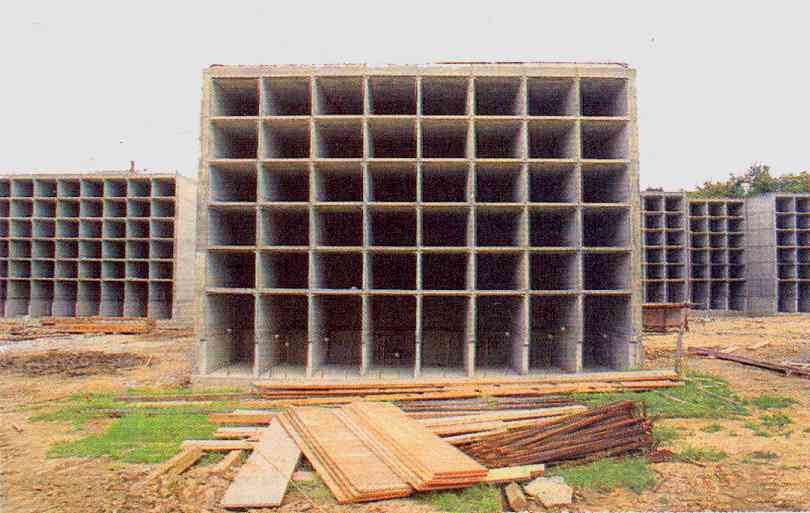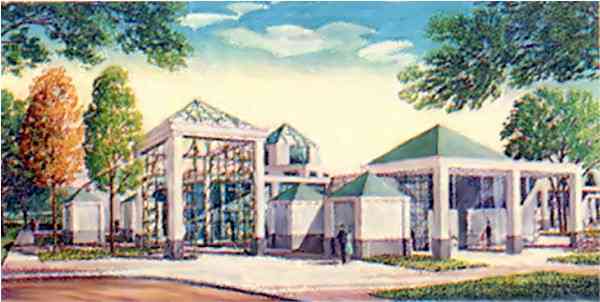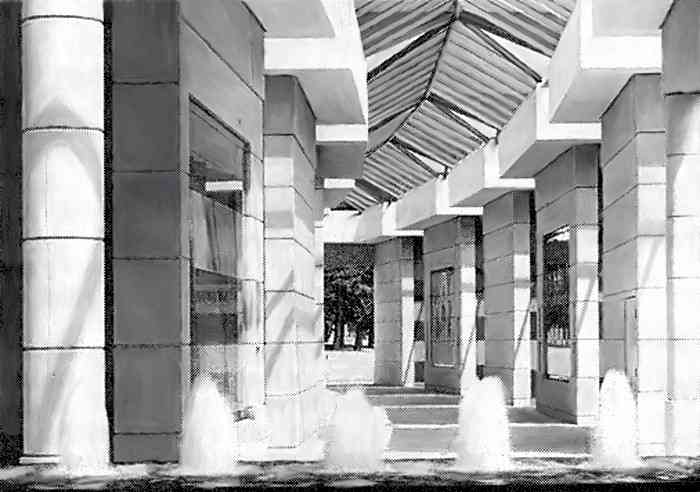A Crypt to Die for
Mausoleums Go UpscaleAs for the pyramids, there is nothing to wonder at in them so much as the fact that so many men could be found degraded enough to spend their lives - Henry David Thoreau
In progress: Garden Conservatory Mausoleum at Woodlawn Cemetery in the Bronx
by Ray A Smith Mausoleums Get Livelier, Adding Museums and Cafes; Voice Messages from BeyondEveryone's heard about the housing boom, but a tomb boom? Many Americans over the past few years have upgraded where they live. Now, some are raising the standards of where they want to spend eternity. Cemetery owners, driven in part by baby boomers who are planning their parents' burials or preplanning their own, are plotting high-end mausoleums that contain amenities like waterfalls, interactive technology, elaborate chapels, gazebos and even cafes. Some tout computer chips that contain photos, bios and in some cases the voice of the deceased. Mausoleums, which date back to the time of the Pharaohs, are freestanding buildings used for the entombment of human remains. Inside, stacks of crypts containing caskets line the walls, many of them marked with the name of the deceased. Funeral-industry representatives say larger, so-called community mausoleums, as well as cremation burials, have increasingly become a popular alternative for people who don't like the idea of in-ground burials. But while the older mausoleums tended to be somber and foreboding, the most recent ones are a lot more welcoming, decorative and high-tech. Forest Lawn Memorial Parks and Mortuaries in Glendale, California, is planning a three-story community mausoleum complex in Renaissance style. It will feature a 2,700-crypt mausoleum; a statuary garden; an 800-seat auditorium for religious services, lectures and films; a cafe serving coffee and light sandwiches; a space for exhibitions by local artists; and a museum displaying a permanent exhibit of artwork owned by the cemetery. The crypt area will feature technology that lets visitors press buttons on hand-held devices to retrieve photos, history and even a recorded message from the deceased via computer chips affixed to individual crypts. In New York, Green-Wood Cemetery in Brooklyn is constructing a five-story, $16 million, 2,500-crypt mausoleum that will look "more like an office tower you might see in Manhattan." says Lou Bortolin of Portland, Oregon-based Milne Construction Company, the developer. It is expected to be completed in December, and will feature a sawtooth glass roof and two 20-foot skylights to bring in natural light, as well as two four-story waterfalls that flow into reflecting pools. While no one tracks the construction of mausoleums nationally, Tribute, a Delafield, Wisconsin company that provides design and building services to cemeteries, says above-ground burials now account for up to 30% of all burial work it does, up from 5% to 10% just a year ago. The Prairie Home Cemetery in Waukesha, Wisconsin says sales of above-ground burial plots have nearly tripled over the past three years. Cemeteries began building more community mausoleums, which are more space-efficient than ground plots, partly in an effort to preserve burial space, since some have been running out of land. Even with the frills, people in the funeral industry say mausoleum burials are often a few thousand dollars cheaper than traditional burials, which require an outer burial container to enclose the casket in the ground, a headstone, gravedigging, fees for opening and closing the grave and maintenance. The popularity of upscale crypts is a boon for the death industry, which is a pretty stagnant business. The number of deaths per year is growing but not by much. Meantime, profits have been hurt by rising interest in cremation, which is also cheaper than interment since it doesn't require large burial plots or pricey caskets. The mausoleum-building spree is partly an attempt to capture some of cremation's popularity, while boosting revenues by adding bells and whistles that appeal to the deceased's loved ones as well as visitors from the general public. Another factor: "Baby boomers are wanting a more unique statement to be remembered by, for their parents and for themselves," says Douglas Keister, who wrote a book about graveyard architecture called Going Out in Style. Even cemeteries that never before offered above-ground burials are getting in on the tomb building boom. The St Peter's Cemetery in Normandy, Missouri is putting the finishing touches on a $1.3 million, 760-crypt community mausoleum, the first in the cemetery's 148-year history, primarily in response to requests from members of the St Louis community. (Future phases will bring the amount of crypts to 2,500.) The mausoleum, designed by Chicago-based Mekus Studios Limited and expected to open in October, will feature a two-story glass curtain wall overlooking the cemetery, an enclosed chapel and the option of crypts with porcelain picture frames mounted in them. The trend also stems from an increasing tendency among Americans to personalise death ceremonies. Tribute, the Wisconsin cemetery-design company, sells among other things hand-sculpted cremation niches for football fans, decorated with footballs, aerial views of a football stadium, and other images of the game. "The past few decades have seen a great deal of change in what people want to do with their dead," says Gary Laderman, a professor of religion at Emory University. Loved ones want to make sure "there's a celebration of the individual." Mausoleum space can cost anywhere from $1,000 {for a single crypt) to $316,000 {for an eight-body crypt), with extra costs 1f the crypts are at "eye or heart" level. The average cost of an inground burial plot ranges from $750 to $3,000, according to the Funeral Help Program, a funeral-industry watchdog. The total average cost for cremation is about half that. Spaces at mausoleums are often sold far in advance, sometimes before the structures are built. (Prices are slightly discounted in such cases.) Preparing for funerals is something the death industry has been aggressively promoting. Some cemeteries put the funds into an escrow account and use the money to help pay for the construction. If the buyer dies before the mausoleum is complete, he or she is placed temporarily in another mausoleum. Joshua Slocum, executive director of the Funeral Consumers Alliance, a non-profit advocacy organisation based in South Burlington, Vermont, says prepayment "is almost always a terrible idea" because in most cases, it's nearly impossible for people to get a refund on a grave or a mausoleum crypt if, say, they move or change their minds.
All Saints Cemetery, Des Plains, Illinois Beyond the CryptMausoleums are going high-end with museums, waterfalls and even cafes. A sampler:
I'm all for "computer chips that contain photos, bios and in some cases the voice of the deceased." Heck, I'd even keep the bud vases. But the body? THERE IS NO MAGIC! A dead body loses all identity in a short time and there is no excuse for preserving the rotting soup. But this attitude would fly in the face of the so-called "death industry" - after all, their reward for dealing with the grisly is money: maintenance fees in perpetuity. Coffins in crypts have been known to explode from gas build-up if they aren't vented properly. If they ARE vented, insects become a problem. What'll it be? Insecticides and carcinogenic air fresheners or the smell of decay? Why bother?? That said, see also:
Modern CremationCremation is the process of reducing human remains to its basic elements in the form of bone fragments through flame, heat, and vaporisation. History - With the exception of periods of plague and the battlefield, Christianity halted for 2,000 years the common disposition of bodies on top of blazing wooden funeral pyres which left nothing but coals - a process as old as the early Stone Age. It was a symbolic way of honouring the dead and also a reassuring way of being certain that embodied spirits would not come back to haunt the living. While "inhumation," corpse embalming, and coffin and mausoleum burial remain the overwhelming funeral preference, in relatively modern times interest in cremation has been rekindled. (Unquestionably, the Nazi’s use of cremation ovens cast a temporary but heavy pall over this resurgent interest.) The Brunetti cremation chamber, which made use of an even heat that kept flames away from the body, was first shown at the 1873 Vienna Exposition. Almost immediately cremation societies developed in the United States and Europe. By 1875 - 1676, the first crematories were established in England, Germany, and the US (in Pennsylvania). The significant thing about cremation is that one avoids the Big Death Business (in New Orleans, that’s Stewart Enterprises). Process - Presently, the body is first placed in either a cardboard or a wooden casket, either of which was made specifically for cremation. An alternative is a cardboard box which fits into a "rental" traditional-looking casket, removed just before cremation. The "retort," the chamber within the cremation oven, is lined with heat-retaining bricks. The propane or natural gas burns at between 1,400° F to 2,100º F. After 2 hours all that remains are ashes and scorched bone. One pound of live weight yields one cubic inch of ash; for example, a 175-pound person would fill an urn 11 inches high and about 8 inches in circumference - or a shoebox. Everything is swept into a grinder leaving the final ash and tiny bone fragments (collectively called, "cremins" - although many reject the term as ugly) representing about 5% of the original body weight. The chemistry of the ashes includes mostly phosphate, calcium, sulfate, potassium - along with chloride, carbonate, and oxide compounds. Statistics - In 1913 in the US 52 crematories assisted in over 10,000 cremations; in 2003, hundreds more crematories facilitated 693,742 cremations - 28.63% of the total deaths. By 2010, it is projected the number of Americans choosing cremation will rise to 35.07%, and by 2030, 50%. In Canada, it was close to 50% in 2000. In 2002, there were 5,135 cremations in Louisiana, 12.13% of all the deaths; Alabama was the lowest, 4.44%, Nevada, the highest, 60.69%. Disposition of the Ashes - Once the ashes are collected in the urn, there are various options. In 1996, there were a total of 492,434 cremations. 78% placed the remains in urns.
Of this 1996 group, the mean age of the cremated was 69.4 years old. 51.9% of them were female. 88% of total were Caucasians, 3% Hispanics, 3% Asians; 6% African Americans. As to religious affiliation: 58% Protestant, 26% Catholic, 11% Buddhist, 3% Jewish, 2% Hindu. Only Islam, Zoroastrianism, Orthodox Judaism, and Russian and Greek Orthodoxy prohibit cremation; the Catholic Church requires the urn to be buried. Of this same group, 67% had no religious memorial service before cremation, 56.3% had no service afterwards; only 24% had ceremonies before and after the cremation. Examples of Additional Available Options
A search will reveal that there are companies prepared to make agricultural implements, ritual objects, and necklaces out of your ashes - for example, a teddy bear with a Velcro pocket in its back to hold "a velveteen bag with your remains." There are companies which sell urns made of every possible material, from split bamboo, cardboard, wood and marble to bronze. Some are biodegradable and ideal for forest burial. Andy P Antippas Some of the more amusing urn-peddling sites, in addition to the companies listed above: Adam H Kitzes "Hydriotaphia: The sensible rhetoric of the dead’" (2002) geocities.com/katacheson/brownekitz "Hydriotaphia, Urn Burial" en.wikipedia.org/Hydriotaphia,_Urn_Burial
Human Body Weight and Its Effects on Cremationby Alan Kroboth The following article contains information provided at the last CANA Operator Certification Course presented by the Matthews Cremation Division Instructors and CANA's Certification Chairman. CANA acknowledges the contribution provided by the Matthews Cremation Division to our members. Body size (weight) and levels of body fat have considerable effects on the operation of your cremation equipment. A body weighing more than 300 pounds should be treated with caution. It is strongly recommended that you contact your equipment manufacturer for any special instructions PRIOR to performing a cremation of heavy human remains. The following is a general list of items that should be considered when performing a cremation of heavy human remains.
Source: cremationassociation.org
Scattering of Ashes Not the Simplest Taskby Abigail van Buren Dear Abby: I am an attorney who provides legal assistance throughout the country to cemeteries, crematories, funeral homes and trade associations in the industry. I am writing to correct some popular misconceptions that were reflected in some of the letters in your column in the last few weeks. First, all of the letter writers used the term "ashes" to describe cremated human remains. The remains of a cremated body are not ashes as the term is commonly understood. The remains are bone fragments that, if not mechanically reduced, can be too large to scatter: they do not immediately dissolve when scattered. They normally cannot be disbursed and blown away. Unfortunately, the movies and the media have misused the term "ashes" for many years, not realising the problems it causes survivors who attempt to scatter remains in the manner often depicted. Second, while it is permissible in all states to scatter cremated remains, there are legal requirements. No state law allows them to be scattered on private property without the consent of the property owner. Many national and state parks have specific rules, permit requirements and, sometimes, location limitations for the scattering of those remains. Several years ago, representatives of a national park and the leader of an Indian tribe contacted an industry association to complain about illegal scattering of cremated remains on the tribe's sacred burial grounds, which were located within the park. Most cemeteries also have rules and regulations that must be observed. Third, adding an additional memorial for the cremated remains of a second spouse on the cemetery plot where the first spouse is buried has legal implications. When burial spaces are originally acquired, there is an expectation that a surviving spouse will be buried with the deceased spouse in an appropriate manner. If a companion memorial was purchased and installed when the first spouse died, changing the arrangement may require the legal consent of all survivors. In addition, most cemeteries have rules and regulations dealing with burial of cremated remains with human remains and the appropriate types of memorials. Finally when separating cremated remains as a keepsake, it is important to make sure that everyone agrees with the plan. The individuals who have the legal right to authorise a cremation usually have the right to determine the disposition of remains. Also, any individual who takes a portion of those remains should be cautioned to treat them in a respectful and proper manner. I hope this information will allow your readers to provide meaningful memorialisation for their loved ones. Harvey I Lapin, Esquire
Dear Harvey: I hope so, too. This is a subject that many people have enthusiastically embraced - as reflected in past columns. Anyone who wishes to scatter the "ashes" of a loved one should first contact the appropriate authorities to make sure they are in compliance with the law. Source: Daily Record, Morris County, New Jersey, Tuesday 10 July 2001
For articles related to ageing, including feats that can be accomplished, and a non-spiritual look at what happens after death - funerals, jerky, popsicles, fertiliser, ashes, orbit or dust - click the
"Up" button below to take you to the Index page for this Older and Under section. |
 Animals
Animals Animation
Animation Art of Playing Cards
Art of Playing Cards Drugs
Drugs Education
Education Environment
Environment Flying
Flying History
History Humour
Humour Immigration
Immigration Info/Tech
Info/Tech Intellectual/Entertaining
Intellectual/Entertaining Lifestyles
Lifestyles Men
Men Money/Politics/Law
Money/Politics/Law New Jersey
New Jersey Odds and Oddities
Odds and Oddities Older & Under
Older & Under Photography
Photography Prisons
Prisons Relationships
Relationships Science
Science Social/Cultural
Social/Cultural Terrorism
Terrorism Wellington
Wellington Working
Working Zero Return Investment
Zero Return Investment

